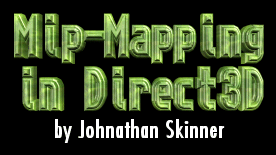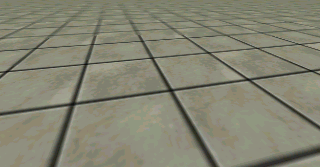11/10 - 11/12 @ Montréal, Canada
12/5 - 12/7 @ Shanghai, China
12/24 - 12/27
2/28 - 3/4 @ San Francisco, CA
More events...
2406 articles in the reference section.
Help us fight cancer!
Join SETI Team GDNet!

|
IntroductionFor those of you who don't know, mip-mapping is a form of anti-aliasing that is used in many 3D rendering engines. It prevents the well-known interference pattern that occurs on detailed textures, known as the 'moiré pattern'. This happens because when the texture is far enough away, there are more texels (texture pixels) then there are pixels to be rendered on the screen. This means that some texels get skipped over, and visual information is lost.  The ugly 'bitty' look near the top is the moiré pattern in action. In a properly anti-aliased rendering, what would happen is all of the texels that land within a single pixel on the screen would be weighted, summed and a final average value is placed on the screen. This could be very processor intensive... just imagine being far away from a small box that has a 256 x 256 texture on it. If this box only covers an 8 x 8 pixel area on the screen, that's 1024 texels per pixel! You would have to sum up and average all those texels just to render one pixel on the screen!!! Obviously this isn't going to happen in real-time. The idea of mip-mapping is simple: if what you are drawing is really big then use a big texture, and if it's small, use a small texture. The great thing about using a smaller texture when needed is that the texel colours can be averaged from the higher resolution texture. And if you use a texture that has a less or equal number texels for the pixels to be rendered, then there is no moiré pattern.  Same scene rendered using mip-mapping. |
|||||||||||
|
|
|||||||||||